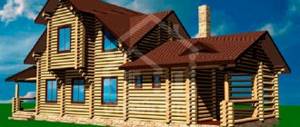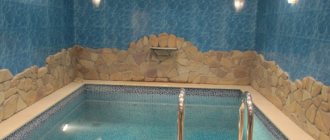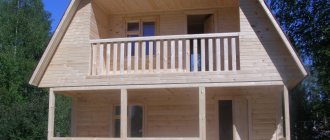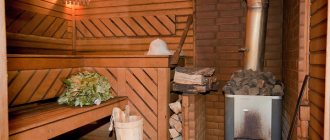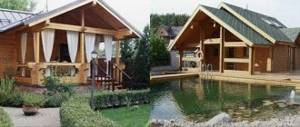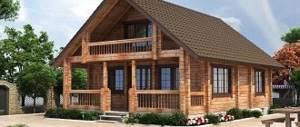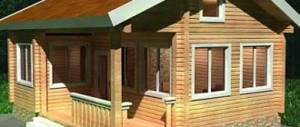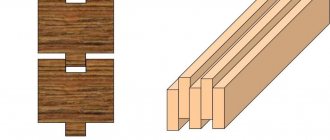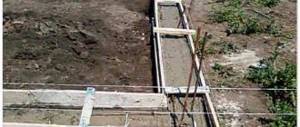Building a bathhouse on a site is not an easy task, requiring a significant investment of time and effort. To avoid problems during construction, professionals advise first creating a project with the dimensions of the future structure, taking into account all the features of the site. This is important because the location of the bathhouse directly affects the durability of the structure. In addition, many more important nuances must be taken into account, without which full-fledged construction is impossible.
The first step in building a bathhouse is to accurately determine its location on the site. It is rare that plots of land are completely level, but even less often is land ownership impressive in size. Therefore, the owners have to resort to various tricks at the planning stage in order to realize their dream of a bathhouse on their own piece of land.
On the slope
The strength and stability of the baths is ensured by a full foundation. It is all the more important to pay special attention to the foundation if the construction of the bathhouse is planned on a slope.
- A slope of three degrees is considered a level surface;
- A slope of three to eight degrees is considered average;
- A strong slope is a surface that has a slope of more than ten degrees.
Important! The foundation must withstand not only the weight of the bathhouse, but also successfully resist the vagaries of the soil. It is the piles that are at greatest risk, so it is recommended to use a bored foundation to support the structure of the bathhouse.
First, the site is being cleared for the construction of a future bathhouse. Then wells are drilled for screw piles - their depth should be below the freezing layer of the soil. The accuracy of the calculations is important - if one of the piles is in a suspended state, the rest will experience constant overloads. On average, the diameter of the well is about 25 cm. Formwork is made for the entire length of the pile, but it can also be arranged only for the head. The wells are then filled with concrete and connected using a self-leveling concrete slab. This way you can build a foundation for a bathhouse.
6-10 acres
The smaller the size of the plot of land, the smaller the area you have to build a bathhouse. This is logical, because standard summer cottage plots, as a rule, range in size from 6 to 10 acres. It is almost impossible to build a large bathhouse without damaging the garden, so small bathhouse projects are especially popular. There are several points to consider before building a bathhouse.
- The bathhouse should be located as far as possible from the country house, but not close to the fence;
- To save space on the site and add additional living space, you can build a bathhouse with an attic;
- In small areas it is better to build baths from fire-resistant materials - from blocks, stone and brick;
- The bathhouse can be combined with other buildings, in particular, with a garage or utility room.
It is best to build a rectangular bathhouse in the corner, 2 or 3 meters away from the fence.
At the same time, you also need to pay attention to the neighbor’s house - there should be at least 6 meters from a long bathhouse to any living space. The main thing is not to skimp on materials for construction - this way the risk of fire will be lower, and the bathhouse will delight you with its durability.
Buildings up to 30 sq. m
Small village bathhouses have many positive aspects, which is why compact structures are becoming the most common in summer cottages.
- Small baths up to 30 sq. m are much cheaper - less building materials are required, as well as a lighter foundation;
- Due to their compactness, such baths can be built on any site;
- A smaller rural bathhouse requires less fuel to fully heat up.
Moreover, compact hut baths remain functional even with minimal equipment. You can safely combine a dressing room with a relaxation room. You can completely abandon the latter if you replace it with a terrace. In the summer, such a step is justified, but if a stone bathhouse will function all year round, then you cannot do without a small changing room. You also need a firewood rack if you have a traditional stove.
Information. For a small bathhouse, it is not at all necessary to build a full-scale brick stove - you can install a mobile metal structure, from which heating is carried out throughout the bathhouse. If the steam room is attached to the house, then all engineering systems are supplied to the bathhouse from the main building.
Distance from bodies of water
Among the many options for places where it is better to put a bathhouse, the ideal place is considered to be a place near water - a lake, river, pond, reservoir. To prevent flooding (especially when there is a threat of floods), the building is located 15-30 meters from the edge of the bank. Regardless of whether the reservoir is natural or artificially created, wastewater from the bathhouse should under no circumstances enter it. To avoid the leakage of dirty water during the bath, install a reliable sewer drain leading in the opposite direction from the reservoir.
Varieties
Russian steam rooms fully correspond to traditional ideas about a private bath. Classic design, wood heating and an amazing atmosphere are why the Russian bathhouse is still at the peak of popularity not only in the countries of the former Soviet Union, but throughout the world.
Depending on the available space on the site, you can build a full-scale stone bathhouse with a large number of functions and rooms, or you can make a small one, where one room combines the purpose of several rooms. Often a bathhouse is built from wooden beams, but with the development of technology it has become possible to pay attention to other materials. This design has many different subtypes, so you can choose a village bathhouse according to your taste and budget.
Village
The classic version is a rustic Russian bathhouse. As a rule, such buildings are built from the most accessible material - wood. The inside of the bathhouse is also lined with wooden material made from aspen or linden. It is only important to take into account some of the nuances of wood construction.
- You need to prepare for a long wait—wood drying can last from 6 to 12 months;
- All wooden elements require treatment with antiseptics and anti-rotting impregnations;
- Wood allows water and heat to pass through well, so insulation and vapor barrier are required;
- The structure lends itself well to finishing, but usually the outside logs are left untouched;
- Wood is convenient because it can be easily cut - this way you can build openings of unusual shapes.
It is imperative to install a layer of insulation under the casing, as well as a vapor barrier.
You can also use coniferous wood for finishing - depending on the temperature, they smell very pleasant. Only in the steam room should you exclude pine needles, as they will begin to release resin. It is also worth putting rubber mats in the steam room for additional safety.
With a cellar
A bathhouse with a cellar is one of the most interesting solutions for a summer cottage. This is due to the same space savings - the cellar will be cold enough to store winter supplies. It is also safe, because many people have no idea about the presence of an underground room in a bathhouse. And this is excellent protection against thieves.
Important! It is necessary to protect the floor in the bathhouse with an additional layer of waterproofing, as well as provide good drainage so that the cellar remains dry.
A basement can have several purposes:
- Utility room;
- Living room.
The cellar is also convenient because it can store a variety of bath accessories, as well as fuel. But with proper skill, the basement floor can be converted into a living room or a recreation room. With any option, the walls will require insulation and protection from water, as well as good finishing and a heating system. In no case can you save on such things, so most often the cellar is given its direct purpose - storing useful things and supplies.
With firewood
Another convenient and cost-effective solution is a bathhouse with an attached firewood rack.
Fuel can be immediately stored in large quantities and stored.
If necessary, firewood for kindling is simply transferred to the bathhouse.
This is convenient because you don’t have to go far to find them.
There are two types of firewood:
- Open;
- Closed.
In the first case, the firewood shed is a simple canopy on poles that does not have walls. Sometimes the room borders the bathhouse, and therefore may have one wall. In another case, the firewood shed is a full-fledged room in which fuel is stored. There are hooks on the walls - you can hang useful things on them.
The firewood can be laid out in any order, but sometimes, for convenience, the room is divided into four “corrals”, between which there is a small passage. A closed firewood shed can be made in the form of an extension to the main building, or its presence is planned in advance, and the required area is included in the project.
Attention! You should not make the firewood box too large, otherwise it will be inconvenient to use.
Hut
As popular wisdom says: “with the darling there is heaven in the hut.” A bathhouse of this type fully corresponds to this statement. The unusual triangular design is very convenient to use; moreover, the triangle is the most rigid shape, which provides the bathhouse with additional strength.
Unfortunately, it is difficult to fully appreciate the convenience, because the walls are sloped.
The stronger it is, the smoother the wall, but the space becomes smaller.
From an aesthetic point of view, the sauna-hut looks interesting; in addition, there will always be a small attic in which you can store things or arrange a relaxation room.
If sloping walls cause discomfort, then they can be sheathed and made absolutely straight.
The hut has two important advantages:
- Two large roof slopes that will not allow snow to accumulate;
- Significant space saving, allowing the bathhouse to be located even near trees.
Such a bathhouse does not have walls, so a hut can be built very quickly even without the help of professionals. It is convenient to divide such a structure into two floors, although the upper rooms will be much smaller. Usually a residential attic is arranged there, and a large recreation room is arranged below.
Dugout
Since the times of Ancient Rus', technologies for building dugouts have been preserved. In fact, the bathhouse is almost entirely in the soil - you need to dig a deep enough hole and strengthen its walls. Then the bathhouse is built according to one of two types:
- Dugout;
- Half-dugout.
In the first case, the bathhouse does not provide any openings other than the door. The walls are strengthened, the roof is installed, and the top and sides of the building are covered with moss and earth.
Information. No additional insulation is needed, but you can’t do without waterproofing. Semi-dugouts rise above the ground and have a small frame with windows on top. The finished building can also be covered with earth so that the heat remains in the bathhouse.
The most important advantage of a dugout is savings. An expensive foundation is not needed, plastic windows are not needed. External finishing is also not needed, nor are fancy stoves - an ordinary brick or metal structure is enough. Insulation materials are also not needed - nature itself provides them. This is why dugouts retain heat longer because they are not blown through by the wind, as happens with ordinary buildings.
Interior design and decorative elements
Details in interiors decorated according to Feng Shui are given great importance. They are responsible for activating various energy sectors, strengthening the weak positions of certain furnishings, and also creating favorable conditions for the circulation of Qi energy. Using them along with the right colors and materials, you can strengthen the positions of various zones and adjust the layout.
It is recommended to use predominantly natural materials. It is a good idea to use those finishing options in the relevant sectors that enhance their significance. It will be wood, metal and stone.
House interior according to Feng Shui
It is not recommended to use artificial analogues, since Qi energy draws its strength from natural sources.
Colors in the interior
Each energy sector has its own color recommended - you can find out which one by looking at the bagua grid. If you follow the existing tips, you can create a harmonious interior in any home. In addition, the kitchen, bedroom and living room have their own colors. Not only the color itself is taken into account, but also the shades, intensity and saturation, as well as the combinations used. The main principle that should be followed is harmony in everything.
Interior details
Interior decoration occurs with meaning. A design project drawn up taking into account the rules of Feng Shui does not accept a single empty but beautiful trinket. If you look closely, you will see only paired objects in the family and love sectors, as well as in the bedroom.
Room interior details according to Feng Shui
Behind each piece of furniture that stands in the center of the room, you can see shelves or shelves with flowers, vases made of natural materials, and wooden crafts.
Mirrors in the interior
Where to hang a mirror in an interior decorated according to the canons of Feng Shui is not only an aesthetic question. Here it is very important to take into account the location of the sectors and analyze how energy flows move. It is better not to hang a mirror in the bedroom. Finding a suitable place will be quite difficult.
This is due to the fact that the sleeping person should not be reflected in it. Mirroring the marital bed is also unacceptable.
This will lead to discord and disagreement in the family. One of the few places where you can hang it is the head of the bed, but its functionality in this case remains in question. But where you can really place it is on the window.
This is allowed to be done even in the bedroom, as well as in those rooms where the window will serve as a portal for the penetration of negative energy. In this case, a mirror placed with the reflective side facing the street will help protect the home from Sha energy.
You cannot hang mirrors opposite doors, this rule especially applies to the hallway where the front door is located, as well as all bathrooms, bathtubs and toilets. The mirror in this case will contribute to the leakage of positive energy from the house.
But where you should hang a mirror is in the hallway. A full-length mirror would be appropriate there. Also favorable rooms for placing mirrors are the living room and kitchen. If you place a mirror opposite the window so that it reflects a beautiful landscape, this will additionally attract Qi energy into the house.
Feng Shui is an ancient teaching, the foundations of which have been formed and developed over thousands of years. Not a single person who decides to arrange their home in accordance with these principles will be able to understand all the subtleties and nuances in a couple of evenings. To achieve complete harmony and really change your life for the better, you need to seek help from Feng Shui consultants. Only in tandem with an experienced designer will they be able to create a home filled with the energy that only you need.
Foundation
The foundation is the fundamental part of the bathhouse, without which it is impossible to do. The heavier the material and the larger the building, the stronger the foundation must be to withstand all impact factors. You shouldn’t do the foundation at your own discretion; it’s better to carry out all the work on the project. It indicates all the key points that will affect the construction process.
- Maximum accuracy of the depth at which the foundation is laid. It is necessary to take into account the depth of the floor outlets and the depth of soil freezing;
- The perimeter of the bath, that is, its length and width;
- Layer-by-layer marking of the entire foundation (pillow, frame and other elements);
- Clarification of individual details - the foundation for a pool or stove.
You can choose the type of future foundation yourself. A strip foundation is chosen for small and lightweight structures; a columnar foundation is suitable for wooden buildings. The slab base is useful for impressive buildings - for example, for a large two-story bathhouse.
You definitely need to know the type of soil on your site - in some cases it is impossible to cope with the task if, for example, you build a real bathhouse complex with several floors on watery soil. Therefore, you need to choose the foundation wisely, taking into account the characteristics of the land. But there is a “golden mean” - a foundation suitable for different types of baths.
On stilts
A pile foundation is the most reliable - it holds loads well and is suitable for areas with elevation changes and high levels of soil freezing.
It easily tolerates minor deformations, supports the weight of multi-story structures, and is also characterized by increased strength.
In essence, a pile foundation consists of several beams driven into the ground, which are connected by load-bearing beams or slabs.
Depending on the soil, you can choose one of four pile construction technologies.
- Pressable, which are lowered underground using hydraulic machines;
- Pressed ones - they are poured with concrete into a pre-prepared well;
- Screw - they work on the principle of self-tapping screws, that is, they are screwed into the ground;
- Drivers, which are driven into the ground with a special device.
Depending on the type of future bathhouse, different materials are chosen for making the foundation - for example, for lightweight structures made of foam blocks or wood, you can use treated pine piles. For heavy structures, steel pipes or reinforced concrete are suitable, but for unstable swampy soils it is worth using combined structures made of reinforced concrete and steel.
It is important to understand that a pile foundation will require a significant injection of funds, because it requires excavation work and a lot of concrete. It’s not for nothing that it is believed that the foundation “eats up” the bulk of the budget for the construction of a bathhouse.
The costs will be justified - a bathhouse on a pile foundation will last for many years.
What are the results of inattention?
Wrong choice and construction of the foundation without taking into account the above factors will appear in the spring, after the snow has melted and the soil has thawed. According to the “politics of nature,” intensive melting begins from the south side and it is in this place that the soil is more susceptible to waterlogging. A columnar base made of brick simply won’t hold up here. Even reinforcement will not give it strength and the savings, for the purpose of which this type of foundation is usually chosen, will flow away with the spring streams.
A monolithic tape base feels more confident in such conditions, but it is also no stranger to weather troubles. And if filled incorrectly, cracks and breaks may appear. Multi-level reinforcement or an anchor platform around the base can improve the situation a little. But this means additional work and the purchase of material. In this case, it is easier and more reliable to make a supporting foundation from reinforced concrete pillars or a pile-screw. The latter involves installing metal pipes to a depth below the passage of groundwater. Installation is carried out with specialized equipment or independently, which is not very convenient and practical.
Construction with stone
For those who are not going to save money, but still want a solid structure, professionals suggest making the building from stone. You can use artificial substitutes (brick, foam blocks), or you can create a real miracle by building a bathhouse from natural stones. Foam blocks are lightweight, but brick and stone baths will require a reliable foundation. But a stone bath is worth it, because it has many advantages.
- The material has high performance ratings, which guarantees strength and durability;
- The stone can be bought at almost any specialized store;
- Shrinkage rate is 8% less than wood;
- The material does not require drying, it can be used immediately;
- The finished bath takes less time to dry;
- The material is environmentally friendly and holds heat well.
It is important to remember that the construction of such a bathhouse will be very expensive, and the construction technology is much more complex than that of wooden structures. The stone definitely requires insulation to avoid the formation of condensation.
It is advisable to finish the outside with plaster, because brick baths do not retain heat very well. But even after twenty years the bathhouse will be in the same condition as on the day construction was completed (if you take care of it, of course). It is important not to forget to heat the building, even if the steam room is not planned to be used. In addition, brick buildings lend themselves perfectly to modifications, and also allow you to build rooms of any shape you like.
